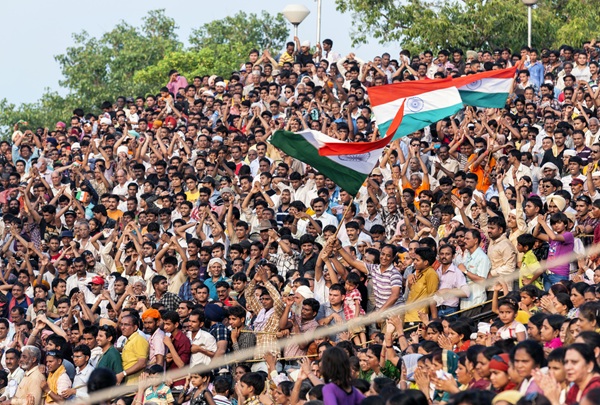.png)

Kalyan Ram, a financial journalist, co-founded Cogencis and now leads BasisPoint Insight.
August 7, 2025 at 9:36 AM IST
Donald Trump’s renewed tariff offensive against Indian exports has jolted New Delhi out of any lingering complacency about its place in the global order. The cumulative 50% tariff, including the additional 25% tied to India’s trade relationship with Russia, is likely to be negotiated down, as trade spats often are when mutual interests align. But to treat this as a mere passing squall is to miss the real warning sign.
For India, the real stress test isn’t economic coercion from abroad. It is the long-standing reluctance at home to complete the transformation that began in 1991.
If the balance-of-payments crisis of the early 1990s forced India to dismantle the Licence Raj and open its markets, today’s challenge is more subtle, but no less consequential. There’s no emergency. Reserves are strong, debt ratios are manageable, and the fiscal stance is broadly disciplined. That, paradoxically, is the danger. Without the spur of necessity, politically difficult changes are easy to postpone.
Yet, the moment demands a response. The choice before India is whether to treat Trump’s tariffs as a fleeting irritant or the start of a clarion call.
Reform Fatigue
India is now the world’s fourth-largest economy, yet as former Reserve Bank of India Governor Duvvuri Subbarao has observed, it remains a poor rich nation. Per capita income is about $2,700, ranking 135th globally. For all its heft, India still faces the risk of falling into the middle-income trap.
The Trump tariffs, combined with global supply chain realignments and sluggish domestic consumption, underscore that the old playbook of growth through incremental liberalisation has run its course.
The unfinished agenda from 1991 is now unavoidable. The first generation of reforms opened markets and reduced the role of the state in production, but left deeper structural rigidities untouched. Land acquisition remains fraught, labour laws fragmented, and contract enforcement unreliable. The resulting friction has stifled large-scale manufacturing and deterred private investment from scaling beyond islands of excellence.
Sustaining 8% growth for two decades, as implied by the government’s Viksit Bharat 2047 vision, requires more than macroeconomic stability. Growth must be inclusive and job-rich, bridging glaring inequalities in education, health, and opportunity. Without that, India’s demographic dividend risks curdling into unrest rather than prosperity.
Second-generation reforms, therefore, cannot be narrowly economic. They are not just about liberalising markets but reimagining governance: reducing regulatory unpredictability, ensuring policy credibility across political cycles, and strengthening state capacity to deliver services. In short, the next reform wave is as much about how the state functions as about what it liberalises.
Resilience, Leverage
What makes this urgency starker is the nature of the external environment. In 1991, India faced a world of post-Cold War globalisation and benign trade winds. In 2025, it confronts a fragmented system.
Tariffs are back in fashion, industrial policy is ascendant, and geopolitics permeates supply chains from semiconductors to energy. Trump’s tariffs epitomise this shift: punitive trade measures linked to strategic alignment rather than purely economic calculus.
This fragmentation offers both risks and opportunities. On one hand, India’s dependence on the US for services exports and on Russia for energy imports exposes it to coercive leverage. At the same time, India’s scale allows it to position itself as a third pole, an alternative attractive to both Western and non-Western economies. To do so, it must build internal resilience. That means deepening domestic demand, diversifying trade partners, and reducing chokepoints in energy, technology, and logistics.
In 1991, the crisis spurred reform. Today, external aggression should spur self-strengthening. The focus should not be isolationism, but selective insulation: developing capacities in critical technologies, securing supply chains, and building buffers against volatile capital flows.
Inclusive Growth
Perhaps the most striking continuity between 1991 and today is the disconnect between aggregate growth and its distribution. Growth numbers alone do not confer legitimacy. The gains of liberalisation have been uneven, concentrated in urban enclaves and high-skill sectors, leaving swathes of the population disengaged from the growth story.
Consumption, which drives much of India’s GDP, cannot accelerate when 800 million people live on subsistence income. Job creation, especially in small and medium enterprises, must be central to the next reform wave. This requires not just easing credit and compliance but also investing in human capital, from quality education to primary healthcare, so that workers can participate in and benefit from higher productivity sectors.
The risk of falling into the middle-income trap is real. Countries like Brazil and South Africa illustrate how commodity booms and initial reforms can propel growth for a generation, only for stagnation to set in when deeper institutional reforms are deferred.
India must avoid that fate by pushing beyond catch-up growth to innovation-led growth, investing in education and research, supporting risk-taking, and nurturing ecosystems that reward talent rather than proximity to power.
Reform to Renewal
The challenge now is to summon the same urgency without the same collapse. The reforms required are harder precisely because they are no longer about removing controls but about building capabilities and trust: between state and citizen, Centre and states, labour and capital. They demand political capital, consensus-building, and patient execution.
Trump’s tariffs won’t break India’s economy. But they reveal how dependent India remains on the goodwill—or at least, restraint—of global partners. The long-term solution isn’t retaliatory trade policy, but internal strength.
This requires a sharper pivot from defensive posturing to proactive economic strategy. The government must set explicit targets for exporters — for instance, pushing top companies to boost non-US exports by 20-25% within a year. It is a bit late to salvage personal chemistry with Trump, but it is not too late to reduce vulnerability to US policy shifts.
A “Kennedy Moment” beckons. Rather than asking what the state must do for business, the Prime Minister should challenge exporters to show ingenuity and resilience, just as he must exhort them to raise research and development spending, which remains woefully low in India. Public incentives can help, but the real test is whether corporate India will invest in innovation for its own survival rather than await state subsidies. This shift, from dependency to enterprise, will define whether India can truly convert adversity into opportunity.
Only then can India credibly aim for developed nation status by 2047. Otherwise, Viksit Bharat risks becoming another dream deferred—by hesitation, when boldness was required most.




